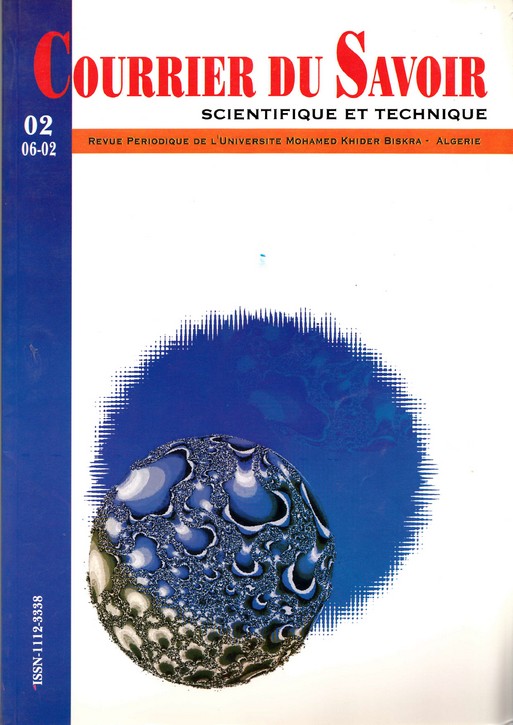UN SYSTEME MULTI-AGENTS
Résumé
Le travail présenté dans ce papier à pour but de réaliser un tuteur intelligent (système d’enseignement intelligent
assisté par ordinateur) en utilisant une approche multi-agents. Cette approche, issue à partir des recherches
abordées en intelligence artificielle distribuées (IAD), vise à répartir un problème sur un ensemble d’entités
appelées agents qui communiquent entre eux pour coordonner leurs comportements intelligents et coopérer afin
de résoudre ce problème. Le problème à résoudre dans cet article est celui de l’enseignement des principaux
concepts de base de données où les différents types de connaissances sont issus de trois sources : l’expert
pédagogique, l’expert du domaine à enseigner et l’étudiant. Pour cela nous avons proposé un système multiagents
dont nous avons distribué les différents types de connaissances sur un ensemble d’agents communicants
par partage d’information via le mécanisme de tableau noir.
Références
oxford University Press, 1962
[BEC 60] Becker H. S. «Notes of Concept of
Commitment », American Journal of Sociology 66,
July 1960
Un système multi-agents pour l’E.I.A.O
77
[BOU 94] Boury-Brisset A.-C, Moulin B., « Mise en
oeuvre de raisonnements multiples dans un système
multi-agent », actes des journées IAD SMA,
Grenoble mai 1994, pp169-182
[BOU 97] Boury-Brisset A.C, Moulin B., « Un modèle
d’agent intégrant des mécanismes de raisonnement
multiple », Revue d’Intelligence Artificielle, Vol. 11
n°1/1997, pp.73-107
[BRI 91]: Brigittte A., Haton J.P, Bouzid N., Charpillet
M.C, « Le raisonnement en intelligence artificielle.
Modèles, techniques et architectures pour les
systèmes à base de connaissances », Inter Edition
1991.
[BRU 97] : Bruillard E. «Les machines à enseigner ».
Enseignement sur mesure, Aspects : EAO, Tuteurs,
micromondes et hypertextes
http:\\www.terminal.ens.eachan.fr\articles\65\multi
mediabaron.html. 1997.
[BUR 91] Burmeister B. and Sundermeyer K. «
Cooperative problem solving guided by intentions
and perception», in Werner E. and Demazeau Y.,
editor, Decentralized AI 3-Proceedings of the Third
European Workshop on Modeling Autonomous
Agents and Multi-Agent Worlds (MAAMAW-
91),pp.77-92, Elsevier Science Publishers B.V.,
Amsterdam, The Netherlands
[DAH 99] : Dahmani F., Ouamer A. « The Expert
Companent of a Distributed Intelligent Tutoring
System for Teaching Algorithmic». Mouloud
Mammeri University. Computer Science Institute.
Compus Hasnaoua B.P.531.RP. Tizi-Ouzou.
Algeria. From The First Mediterranean International
Conference on Computer Technologies, June 1-
3.1999.
[DEP 87] : Depover C.., « L’ordinateur media
d’enseignement ». Un cadre conceptuel. De Boek-
Wesmael, Bruxelles, pp. 235, 1987.
[DUR 87a] Durfee E. H., Gasser V. R. and Korkill D. D.,«
Coherent Cooperation Among Communicating
Problem Solvers», IEEE Transactions on Computers
C-36, 1987
[DUR 87b] Durfee E. H. and Lasser V. R, « Using Partial
Global plans to Coordinate Distributed Problel
Solving», In proceeding of an the 10th IJCAI, Milan,
Italy, 1987.
[EAR 96] Earl C. and Fibry R.« combined execution and
monitoring for control of autonomous Agents »,
Proceeding of the First International Conference on
Autonomous Agents, 1996
[FER 88] : Ferber J. and Gallab M., « Problématiques des
univers multi-agents intelligent », IN actes des
journées nationnales PRC.GRECO. Intelligence
artificielle. Touleuse, mars 1988.
[FER 95] : Ferber J., « les systèmes multi-agents, vers une
intelligence collective », Inter Editions. 1995.
[FRA 99] : Fransis M., Mc cannell S., Odell J., Ratickaine
K., Staut K. et Thampson C. « Agent Technology
(Green Paper) ». Agent Working Group OME
Document ec/99 12.02 version 0.9. 24 december
1999.
[GAS 90] Gasser L., et Hill R. W. « coordinated problem
solvers », Annual Reviews of Computer Science.
4,1990, pp. 203-253
[GOL 77] Goldstein I., Carr B.. « The Computer as a
coach: an athletic paradigm for intellectual
education ». Proc. Of 1977 ACM annual
Conference, Seattle, P.227-233.
[JEN 93] Jennings N. R.,« Specification and
implementation of a belief desire joint-intention
architecture for collaborative problem solving»,
Journal of Intelligent and Cooperative Information
System, 1993, 2(3),pp.289-318
[JEN 95] Jennings N. R.,« Controlling cooperative
problem solving in industrial multi-agent systems
using joint intentions», Artificial intelligence, 74(2),
1995
[KAZ 00a] Kazar O., Sahnoun Z., Frécon L., « Dynamic
Agent Reasoning », Agent Based Simulation I,
Passau, Germany, May 2-3, pp. 175-180, 2000
[KAZ 00b] Kazar O., Sahnoun Z., Frécon L., « Cognitive
Agent Architecture For Medical Care», IC-AI'2000
Las Vegas, The 2000 International Conference on
Artificial Intelligence, June 26-29, 2000 Monte
Carlo Resort, Las Vegas, Nevada (USA)
[KAZ 00c] Kazar O., Sahnoun Z., Frécon L., «Adaptable
Agent Reasoning”, CARI2000,16-19 Octobre 2000,
pp. 273-279, Antananarivo, Madagascar
[KAZ 01a] Kazar O., Sahnoun Z., Frécon L., «multi-
Competence System of Multi-Paradigm », Agent
Based Simulation II, Passau, Germany, April 2-4,
pp. 125-129, 2001
[KAZ 01b] Kazar O., Sahnoun Z., Frécon L., «Multi-agent
systems for Aeronotic simulation », ICCTA 2001,
International Conference on Computer Theory and
Applications, Alexandria, Egypt, 28-30, pp. 5-12,
August 2001
[KAZ 01c] KAZAR O., BAARIR S., « Générateur de Plan
pour un robot », CIP2001, international Conference
on Productic, pp. 55-65, Algiers, 09-11, June 2001
[NIL 80] Nilsson N. J., «Principles of Artificial
Intelligence », Traduit en Français par Anne et
Michel Manago , Cepadues Editions, pp. 150-180,
1980
[SAL 97] Sallantin J., « Les agents intelligents, essai sur la
rationalité des calculs », Edition Hermes,pp. 21-38,
Paris, 1997.
[SEA 72] Searle J. R., «Speech Acts, Cambridge
University Press, 1969, Herman (en Français), 1972.
[SEA 90] Searle J. R., «Intentions in communication,
chapter 19 : collective Intentions and Actions », pp
401-415, MIT Press, London, 1990
[SHO 90] Shoham Y, « Agent-oriented programming »,
Technical Report STAN-CS-1335-90, Computer
Science Department, Stanford University, Stanford,
CA 94305, 1990
[SPE 86] Sperber D. and Wilson D., « Relevance
Communication and Cognition» , Edition de Minuit
en français,pp. 25-45, 1986
O. Kazar.
78
[WEG 87] Wegner P., «Dimensions of object-based
language design », Department of computer science.
Brown University Providence, RI 02919.
OOPSCLA, Proceeding October 4-8, 1987
[WOO 94] Wooldridge M., Jennings N. R., « towards a
theory of cooperative problem solving », in preproceedings
of the sixth European Workshop on
modeling Autonomous Agents in a Multi-agent
World, Demazeau Y., Müller J.P., Perram J., (edts),
1994


